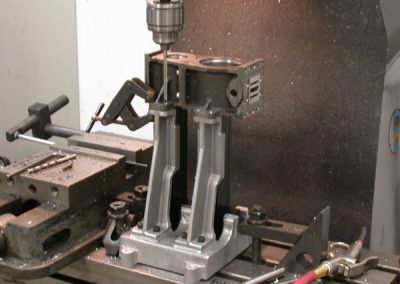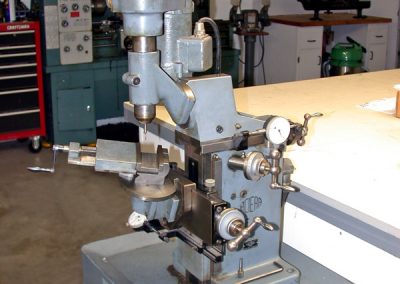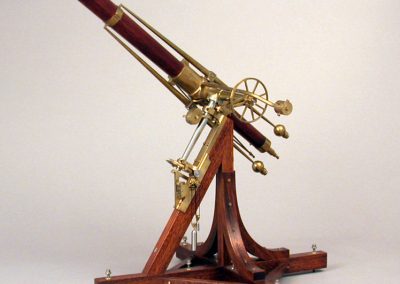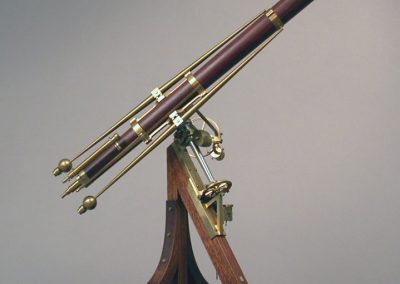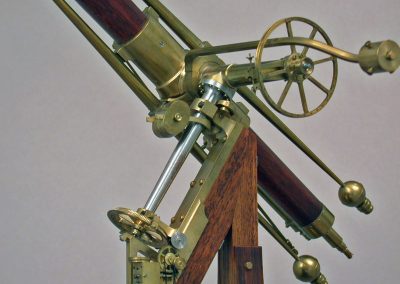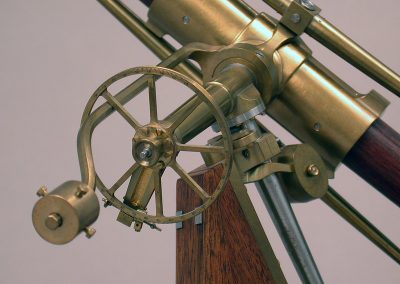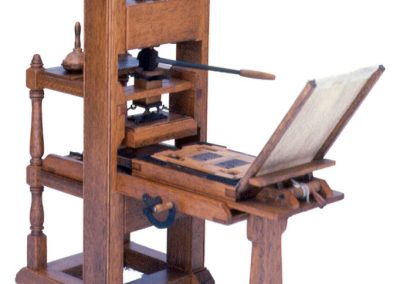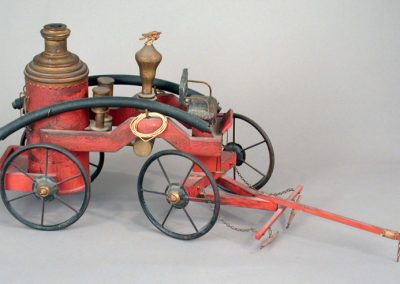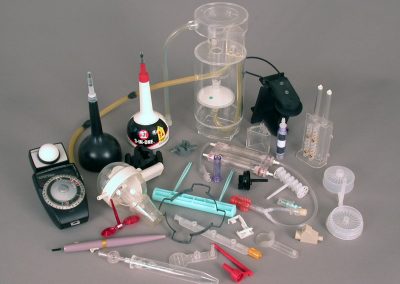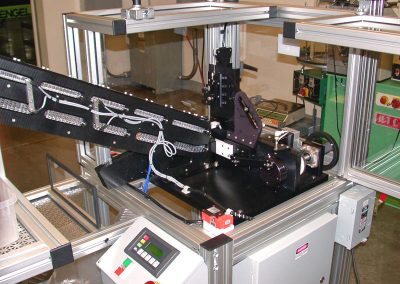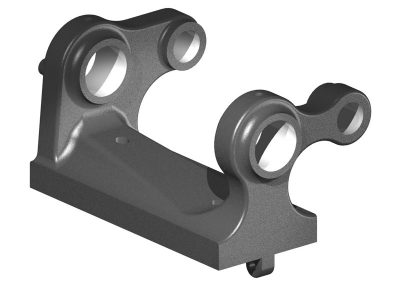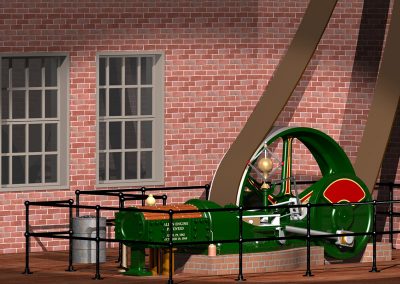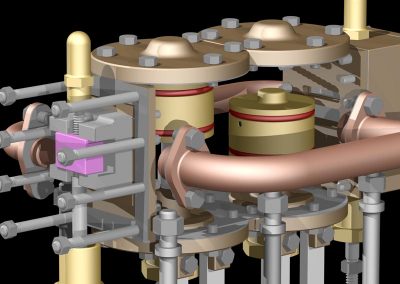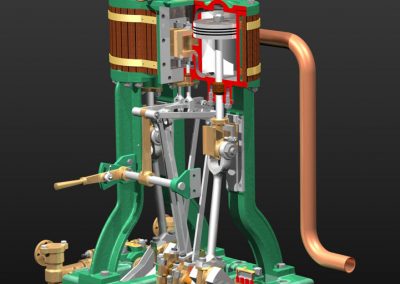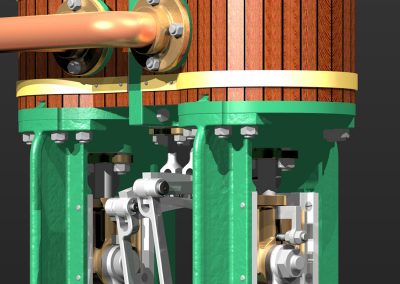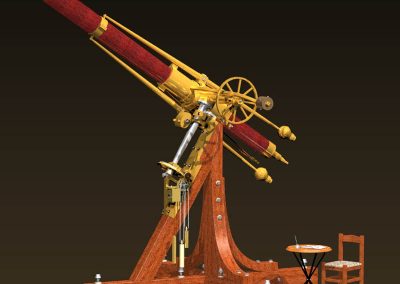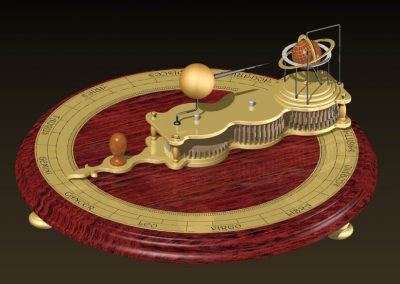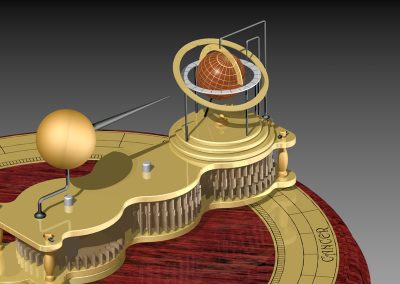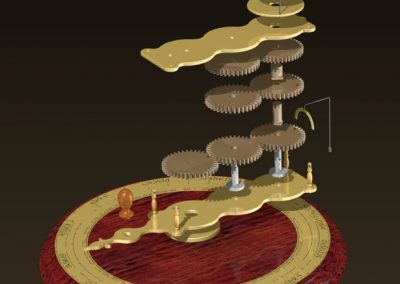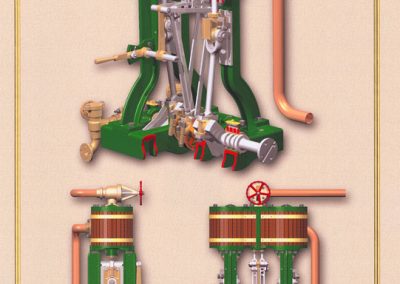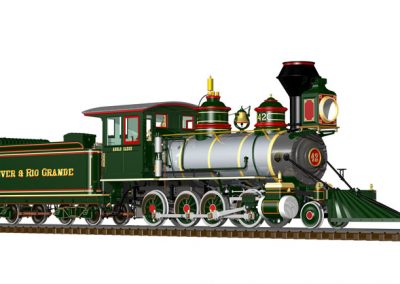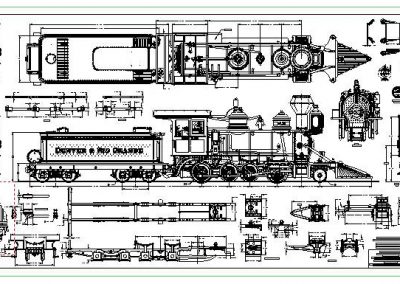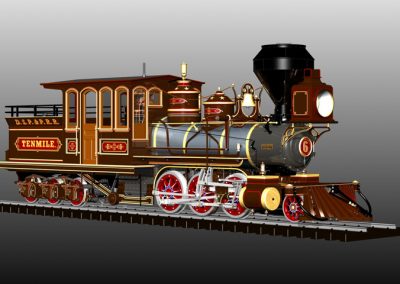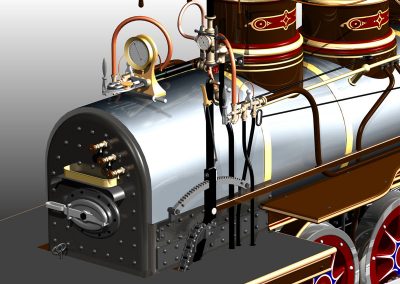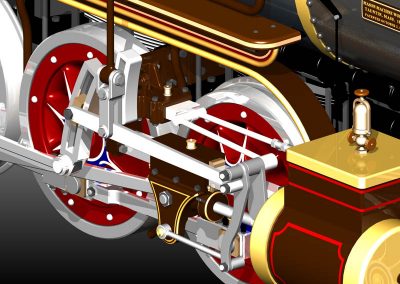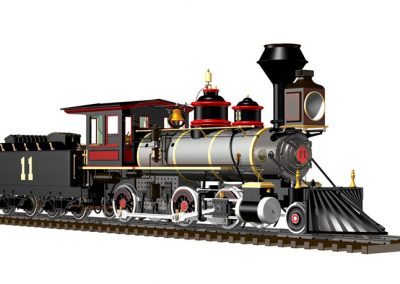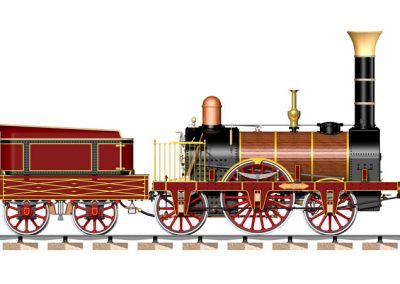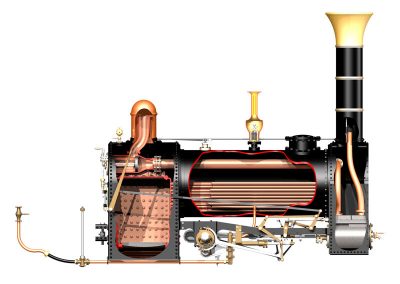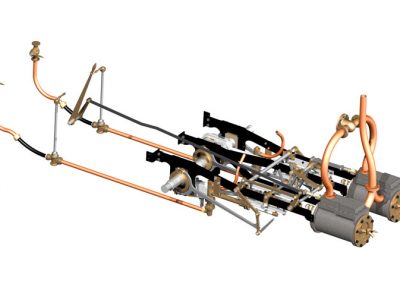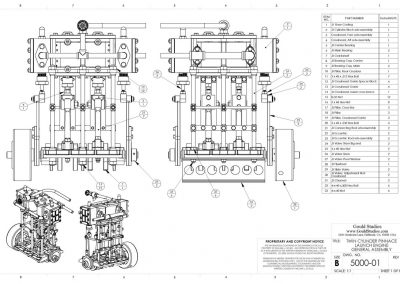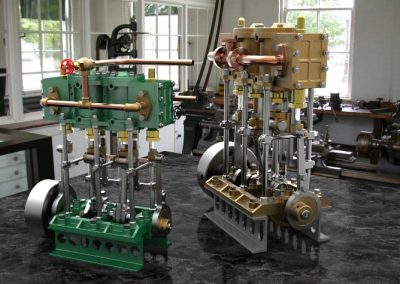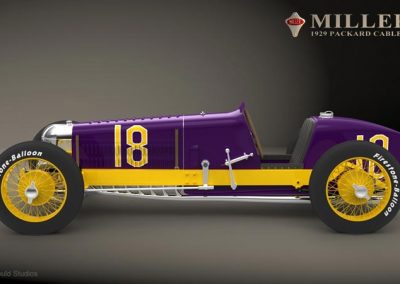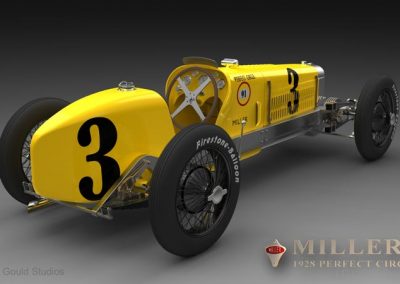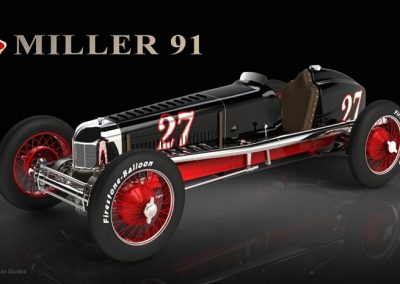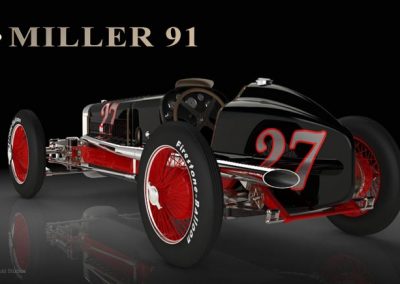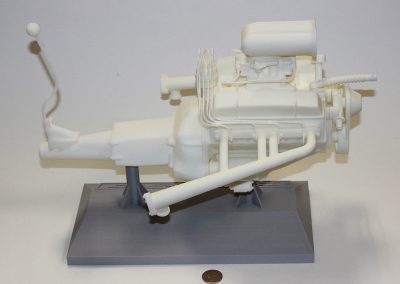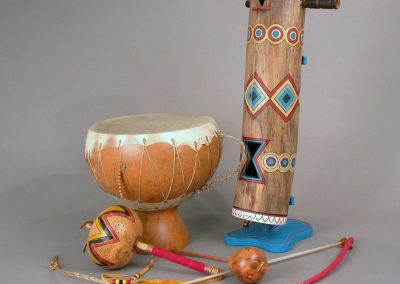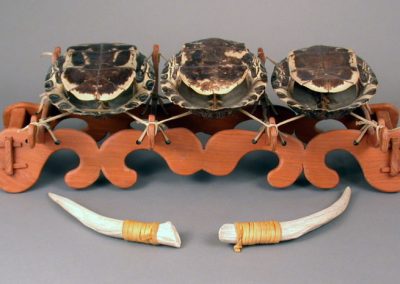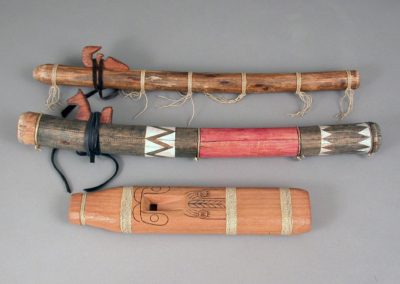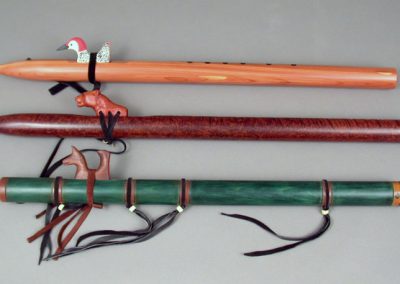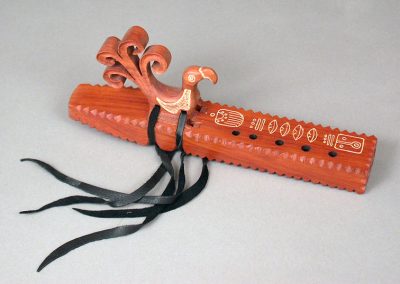Below you can view more photos of Bill’s exceptional craftsmanship. Click on images to enlarge.
Model Projects
Drilling the Cylinder Block
Line drilling the cylinder block for his twin compound steam engine, with alignment fixture in place. Bill had a policy of moving his mill vise 6”-9” to the left or right of center—or on center—every year. This equalizes wear on the saddle ways. Along with that, bill would add a shot of way oil and two shots of spindle oil every day, plus a “deep cleaning” once a year. This kept his machine tools in mint condition.
Bill’s Aceria Milling Machine
This Aceria F-1 precision universal milling machine from Switzerland has an interesting history. Bill had acquired it many years ago from Clifford Grandt, a Master toolmaker and founder of the famous Grandt Line Products. In the early 1950’s, Cliff had used the mill to machine many parts for America’s earliest satellites while employed by the Space Sciences Laboratory, at UC Berkeley.
1/12 Scale Dorpat Great Refractor Telescope
Bill created this 1/12 scale model telescope for the National Geographic Society’s Centennial Celebration, at Explorer’s Hall, Washington, D.C. The model was featured in the March, 1989 issue of Sky and Telescope. It was also included in Fine Woodworking Design Book Five, as one of 259 of the “World’s Best Works in Wood” (chosen from 1600 entries). The original telescope was made by Joseph von Fraunhofer (1787-1826), who discovered the dark absorption lines in the spectrum of the sun now known as Fraunhofer lines. He is considered to be a founding figure in astrophysics.
1/12 Scale Dorpat Great Refractor Telescope
The Great Refractor telescope was the first application of Fraunhofer’s invention of the equatorial mount and clock drive. The telescope had an aperture achromatic lens of about 9-1/2”, f15, making it the largest telescope in the world in 1823. It’s still considered one of the most important scientific instruments in history. The original telescope is on display at the Dorpat Observatory Museum in Tartu, Estonia. Bill researched the telescope through numerous museums and libraries, which provided copies of the maker’s drawings. He also worked directly with the curator of the Dorpat Observatory, who provided many detail photos and measurements.
1/12 Scale Dorpat Great Refractor Telescope
This view offers a closer look at the equatorial mount and clock drive. Also showing is the tapered tube/ball counterweight system to minimize flexure of the telescope tube at various positions. An oval counterweight controlled the thrust bearing of the polar axis shaft. Bill used Ramón, an extremely hard, fine-grained wood from Central Mexico, on the telescope. He stained it with Tandy brand leather dye to represent the oak and mahogany of the original.
1/12 Scale Dorpat Great Refractor Telescope
The model itself is fully functional, with the exception of the optics. This view shows the “Setting Circle,” which features engraved lettering only .025” high! Interestingly, a similar Fraunhofer “9-inch” refractor telescope at the Berlin observatory was used by Johann Gottfried Galle in the discovery of Neptune!
1/12 Scale Dorpat Great Refractor Telescope
The telescope model is shown here with a few of Bill’s tools. Many of those tools, including the bow compass and ink drafting pen, were used by Bill’s grandfather—a noted architect himself.
1/12 Scale Franklin Printing Press Model
This model printing press was also exhibited in the National Geographic Society’s Centennial Exhibition, along with the telescope. It was acquired for the permanent collection of the Kansas City Miniatures Museum. The model printing press is fully functional, and could actually be used to print the small pages from photo-reduced, etched, and machined type.
Toy Fire Engine
Bill found a set of antique toy wheels in a junk shop in 1964, and decided to craft this “steamer.” The model is complete with an aged crackle finish, which was achieved with a blowtorch. Many collectors had asked to purchase it until Bill told them the real story of its origin!
Injection Molded Plastic Parts
Just a sampling of many thousands of prototype plastic injection molded parts for Bill’s commercial clients.
Gould Automatic Assembly Machine
This is a high-speed automatic assembly machine that was designed and fabricated by Gould for a medical device client.
CAD Projects
Engine Lathe CAD Model
A SolidWorks/PhotoWorks rendering of a 12” x 60” engine lathe, circa 1897. Everything other than the landscape was created in CAD.
Allen Engine Works Mill Engine
This mill engine, with a Porter governor, was 12” x 24” and single cylinder. This CAD model was based on the original builder’s catalogue, from around 1888. Bill created this in SolidWorks model, using the PhotoWorks photorealistic imaging add-in.
Pinnace Launch Engine CAD Model
This CAD view shows the engine during the design process, with the cylinder block hidden. The slide valve nut is pink, indicating to Bill that it was an unfinished part.
Twin Simple Steam Launch Engine
This is a 7” x 7” twin simple steam launch engine, modeled to actual size, and sectioned to illustrate assembly and function. The CAD model was based on designs from Machine Drawing and Design, by Ripper, published in London in 1879. The book was made to be a drafting exercise handbook for students. It’s likely that this lovely engine was never actually made. Bill found that all the parts fit perfectly, and the cyber model was fully functional and animated.
Dorpat Telescope CAD Model
Bill created this CAD model for Fraunhofer’s telescope in 2006, using the research and drawings he did in the mid 1980’s—when he made the 1/12 scale model for the National Geographic event.
Dorpat Observatory CAD
Bill’s rendering of the Dorpat Observatory, Tartu, Estonia (former USSR). Considering that the telescope tube is fifteen feet long, the image gives a good sense of scale.
Ferguson’s Mechanical Paradox Orrery
Ferguson’s Mechanical Paradox Orrery. This orrery demonstrates the position of the earth and sun at various times of the year. The CAD image was based on a contemporary illustration by James Ferguson, published in 1779.
Orrery Detail
Bill was fascinated by scientific instruments like this, and sought to share his CAD models with interested peers.
D&RG Locomotive CAD Model
Bill’s rendering of a D&RG class C-16(60) narrow gauge 2-8-0 locomotive, shown as it was built in 1881. Bill created the CAD model from his own collection of copies of nearly all the original builder’s drawings. Because of that, the rendering is likely the most accurate assembly available today, and a vital resource for historians! More renderings of this locomotive can still be found on the Gould Studios website.
The D&RG Blackline Plan
These plans for the C-16 locomotive demonstrate some of the capabilities of SolidWorks.
Denver, South Park and Pacific Railroad Mason Bogie
This was considered to be Bill’s “CAD Masterpiece,” the famous Denver, South Park and Pacific Mason Bogie, as built in 1879. Bill was awarded 2nd runner-up in the SolidWorks 2006 International Design Competition, competing with hundreds of entries by major firms from around the world.
Mason Bogie CAD Detail
A closer view of the backhead. Bill’s rendering was also featured in the May 2006 issue of Cadalyst Magazine, along with some podcasts and numerous websites, too. This cyber model represents the first time this loco has been seen in correct colors since the original was scrapped in 1881!
Mason Bogie Valve Gear
This model required over 400 hours of research and design. Bill made it in cooperation with experts including David Fletcher, from Australia, and Jim Wilke, a noted railroad historian and color authority to many museums.
Stephenson’s Patent 2-2-2 Locomotive
Another SolidWorks project that Bill completed down to the last nut and bolt. The original locomotive was from 1836.
Stephenson Boiler and Frame
This sectional view of the CAD model shows the amazing amount of detail incorporated. Keep in mind that each part was individually modeled!
Stephenson Frame and Running Gear
Another detailed view of the frame and running gear. Because the model is fully functional, moving the reverse lever also adjusts the “Gab” valve gear.
Stephenson Locomotive CAD
The CAD model could be rotated to any position, and parts or assemblies could either be hidden or made partially transparent for viewing.
Gould Engine Plan
From this plan to the rendering in the following image, it’s hard to believe the engine doesn’t actually exist.
Engine CAD Rendering
Here the engines appear to sit in a well-lit shop on a granite table, but it was all done in SolidWorks.
Miller 91 CAD Model
One of Bill’s projects was to model classic race cars in highly detailed 3D, and to offer them as quality prints. The Miller 91 was a popular race car of the 1920’s and 30’s. It is seen here in raw, unpainted metal. The following versions exhibit several famous paint schemes for the car.
1/4 Scale Chevy Racing Engine
This 1/4 scale model of a Chevrolet racing engine is an example of 3D printing or “rapid prototyping.” It was produced using a FDM method (Fused Depositon Modeling) that builds up the object by depositing small drops of ABS plastic.
Musical Instruments
Handcrafted Musical Instruments
A selection of Bill’s handcrafted musical instruments. The “Apache Violin” (right) was modeled after examples in the Heard Museum. The violin was made from a dead agave cactus stalk, and features a single string. The bow at the bottom was made from willow with horsehair. A little known fact is that the famous warriors, Geronimo and Cochise, were both noted for making and playing the Apache Violin. The smaller rattle is a Hopi design made with gourd and tiny seeds. The larger rattle is typical of those used by Geri’s tribe, the Gabrielino/Tongva, the original inhabitants of the Los Angeles Basin.
An Ayotl
This somewhat unusual instrument, called an Ayotl, is of Mayan Origin. The original instruments were typically a single large sea turtle shell, hung from the neck. Bill’s concept is perhaps the first “multi-shell” Ayotl ever created, according to a musician friend and authority on ancient Meso-American music. Each shell produces three distinct notes, so Bill had to sort through hundreds of shells to find the right combination. The end result is a progression of nine “naturally” tuned notes. It can only be played with deer antlers!
Bill’s Traditional Native American Flutes
Bill referred to these as, “The Old Ones.” These flutes were crafted in the traditional style: hand-split, carved out, and reassembled with natural hide-based glues—often using sinew bindings. They were made to “anatomical” dimensions and tuning. This means that the length is from the tip of the middle finger to the elbow for an “A” key, or to the shoulder for an “F” or “F#”—with all other dimensions taken from the width of the palm or thumb. The bottom is a replica of a Klingit Owl Whistle, which plays bird calls including the traditional hoot of an owl.
Bill’s Native American-Style Flutes
Three of Bill’s flutes, which he made under the AHõKEN name—meaning “soft wind” in the language of Geri’s tribe. Bill crafts from western red cedar, Sitka spruce, cherry, and exotics. The center flute, Bill’s personal performance and recording instrument, is redwood burl inlayed with maple. It was entirely hand-shaped, as the burl was too chippy for lathe turning. This style of flute is concert tuned.
A Tocan
Another more unique flute compared to Bill’s original enharmonic tuning concept and design. This Tocan is a “double,” with the playing holes on one side, while the other bore is a drone. Crafted from Chotke-coc, this is the natural color. The Tocan was embellished with a glyph set depicting the entire span of the Mayan calendar, from 3113 BC to AD 2012. Though only a small flute at nine inches long, it is powerful, and takes considerable skill to play.

